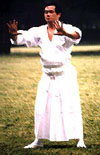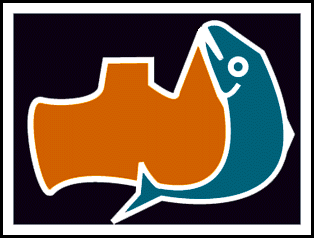| Where the Foot is Mightier than the Sword |
The story developed by the Port Pirie workshop (Betty Edwards, Jean Brakenridge, Fay Green, Jean Fabris, Loreto Hewitt, John Liebelt, Maria Kanaris, Barbara Ryanon) Monday 28th July 1997 is presented below.
 Shao-lin developed out of a
scenario in which traders from Okinawa settled in what we know as Australia while seeking
refuge from the Portuguese. On their trail, the imperial Japanese navy follows to
establish a military stronghold on the foot of Southeast Asia. As the workshop unfolded,
participants considered the difficulty by which such an insular people as the Japanese
would cope with the wide-open spaces. Their eventual inability to control the continent
leads to a retreat south, populating Minamin (what we know now as Tasmania), with a feudal
samurai society. In their wake, the continent evolves as a loose federation of
nationalities, including mainly Aboriginal tribes, Okinawans, Chinese and Dutch. They
trade economic strength for co-existence.
Shao-lin developed out of a
scenario in which traders from Okinawa settled in what we know as Australia while seeking
refuge from the Portuguese. On their trail, the imperial Japanese navy follows to
establish a military stronghold on the foot of Southeast Asia. As the workshop unfolded,
participants considered the difficulty by which such an insular people as the Japanese
would cope with the wide-open spaces. Their eventual inability to control the continent
leads to a retreat south, populating Minamin (what we know now as Tasmania), with a feudal
samurai society. In their wake, the continent evolves as a loose federation of
nationalities, including mainly Aboriginal tribes, Okinawans, Chinese and Dutch. They
trade economic strength for co-existence. 
The name Shao-lin comes from the martial arts temple in China-their followers seek refuge in the southern island. The Okinawans, who developed karate out of Chinese techniques, gratefully accept their mentors and a new synthesis of aggression, spirituality and dance emerges out of the contact between the two Asian peoples and indigenous tribes.
Timeline
1400s Okinawan Empire flourishes as entrepot for goods from China (to whom it is
tributary), Japan and Indonesia.
1511 Admiral Albuquerque leads Portuguese navy in gaining control of the Melacca straits.
Traders like the Ryukyu from Okinawa forced to seek goods further afield
1513 Ryukyu boats first touch on northern tip of the large continent south of Java, rich
with expensive sea creatures, such as dugong, and wealth from pearls. After initial
conflict, agreement reached with local Aboriginal population after exchange of goods.
Small fishing communities develop along northwestern coast
1600 Japan invades Okinawa and continues to develop sea-faring technologies
1610 Japan develops fleet of Spanish sea ship to claim the southern continent and the
mantle of Asian empire, comparable to the European nations, such as England, Holland,
Portugal, Spain and France.
1612 Japan invades the southern island and enslaves the existing population. At first,
they meet resistance, but their superior weaponry assures short-term victory
1655 Japanese invade Hokkaido and ship existing Ainu south to help as slaves.
1670? Treaty between the Japanese and the Dutch for mutual protection against the English
1780 War of the South between the English colonisers and the Japanese, assisted by the
Dutch. English fleet is destroyed. Meanwhile, rebellion on land forms against the
Japanese. Retreating Japanese army is given assistance by Dutch to seek refuge in Van
Demen's Land. An increasingly insular Japan fails to provide more support to Japanese in
conflict overseas.
1800 Various peoples from south-east Asia gravitate to the continent, such as Chinese
seeking refuge from the Ming dynasty.
1812 Nation of Shao-lin formed as a loose federation of many different regions. As an
Asian version of Switzerland, it included a mixture of different peoples: Okinawan,
Aboriginal, Chinese, Dutch, Japanese, and Ainu.
1890 Chinese settlers discover gold and start mining the land, creating conflict with
local Aboriginal peoples. More Chinese and Asians follow.
1940 Japanese forces invade Shao-lin, using it as a base for their take-over of Asia. They
are surprised by the cool reception, even in Van Demen's Land, where the inhabitants
resent being treated as inferiors.
1943 Bombing of Aukland
1944 Invasion of New Zealand
1948 Japanese are defeated. Many Japanese soldiers elect to stay on in Shao-lin at the
bequest of the Emperor
 |
Shao-lin today is a relaxed country. Different communities specialise in different industries: Okinawans control fishing, Aborigines organise tourism, the Japanese make handicrafts, and the Chinese run the mining and oil industries. It's only presence on the Olympic podium is limited to an occasional bronze for rowing. Sporting energies are focused instead on the annual festival of martial arts. The state religion is mixture of Aboriginal ritual and Shinto. On the national day, shells representing the invading Europeans are cast into the ocean as reparation for the white souls killed in sea battles. |
Minamin continues Japanese culture along strictly traditional lines. It is ruled by Samurai warlords who exploit the local population. These people saw the Meiji Restoration in Japan as a betrayal of the throne. Instead of the actual emperor, the Shiramachi shogunate is given the responsibility of answering on his behalf. Using metals acquired from Shao-lin, the gold and silversmithing in Minamin gains a reputation as the best in the world.